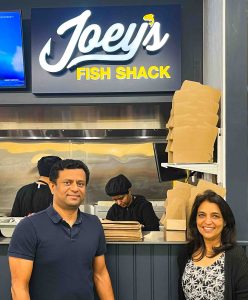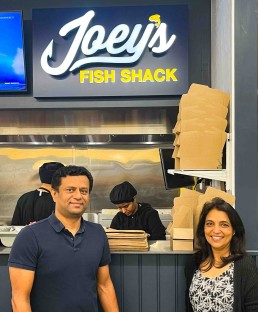
We’re excited to share some great news with you: Joey’s Fish Shack has officially opened its doors inside Taylor’s Convenience in Wallaceburg, Ontario! This unique location is off to an incredible start, showcasing the power of collaboration and community support.
By joining forces with Taylor’s Convenience, Joey’s Fish Shack is offering customers a fresh and flavorful dining option alongside their everyday shopping needs. The results so far have been outstanding. The restaurant has brought a new wave of foot traffic into the convenience store, while customers who come for their daily essentials are discovering the irresistible dishes Joey’s is famous for.
This location is more than just a restaurant—it’s an example of what’s possible when businesses work together to meet local demand. Joey’s Fish Shack brings the brand’s fresh seafood and welcoming atmosphere, and Taylor’s Convenience complements the experience by offering customers the added benefit of one-stop shopping. Together, they’re creating a community hub that’s delivering excellent results for both businesses.
The Wallaceburg location has already exceeded expectations in its first few weeks, and we’re excited to see this momentum grow. With the flexibility to open in a variety of settings, Joey’s Franchise Group continues to show how adaptable and successful our concepts can be, creating value for franchisees and the communities they serve.
If you’ve ever wondered how a Joey’s Fish Shack or Streats franchise could fit into your business or community, this is a perfect example of what’s possible. Click the button below to book a call and discuss your vision with our team.
27 January 2025
Streats Harvey Kitchen is Now Open in Kelowna, BC!
We’re thrilled to announce the grand opening of our newest Streats location in the vibrant city of Kelowna, British Columbia! Nestled in one of BC’s most picturesque and growing communities, this new store is ready to serve up our signature flavors and welcoming atmosphere.
Kelowna’s unique blend of a thriving local economy, active lifestyle, and supportive community makes it the perfect spot for our expanding Streats Kitchens family. This location will bring a fresh, fast-casual dining experience to a city that values both quality and convenience.
As a brand that’s growing across Canada, Streats Kitchens is committed to providing our franchise partners with the tools and support they need to succeed. From proven operational systems to trendy and innovative menu development, we work hand-in-hand with franchisees to make their entrepreneurial dreams a reality.
Kelowna’s new store is a shining example of what’s possible when great locations meet great partnerships. If you’ve been considering joining the Streats Kitchens family, now’s the time to explore the opportunity. Let’s work together to bring fresh, crave-worthy dining experiences to even more communities.
Want to learn more? Get in touch today—we’re excited to help you take the next step in your franchising journey!
Joey's Fish Shack Wallaceburg: Opening Soon!
We're thrilled to announce the upcoming opening of our newest Joey's Fish Shack, located in Wallaceburg, Ontario! This exciting new spot will open inside one of the area's most popular convenience stores, making it the go-to destination for quick, delicious seafood on the go.
Our Wallaceburg location brings Joey's signature fresh, sustainable seafood to the heart of the community, offering a unique partnership with a high-traffic retail space. It's a setup that benefits both the convenience store and Joey's, providing customers with an easy, accessible dining option while boosting visibility and foot traffic for both brands.
This innovative approach demonstrates how our franchise model can thrive in a variety of settings, from standalone locations to strategic partnerships like this one coming to Wallaceburg. The flexibility of our franchise opportunities means you can explore locations that work for you—whether it's in a bustling shopping area or, like Wallaceburg, in a popular area frequented by both locals and visitors from the surrounding smaller communities.
We can't wait to serve our famous fish and chips in Wallaceburg, and we'd love to have more dedicated franchise owners join us on this journey of growth and success.
Could you envision yourself as the next Joey's Fish Shack franchisee? If you’re interested in learning more about franchising with Joey’s, please reach out to our Franchising Team.
Opening Soon: Streats Kelowna Kitchen
We’re thrilled to announce that Streats Kitchens is expanding once again—this time to the beautiful city of Kelowna, BC! Our newest location will soon be serving up the delicious and diverse flavors you've come to love, right in the heart of the Okanagan. With fresh, globally inspired street food, we’re bringing something exciting and unique to the local food scene.
What’s Coming to Kelowna:
- A vibrant, fast-casual dining experience with options to satisfy every craving.
- Our signature menu featuring the best in global street food—from tacos and burgers to delicious bowls and loaded fries.
- A commitment to fresh ingredients and sustainability that aligns perfectly with the lifestyle in the Okanagan.
Why Kelowna? Kelowna is a fast-growing, dynamic city with a booming food culture. It’s the perfect place for a Streats Kitchen to call home. With its mix of year-round residents and tourists, Kelowna offers a fantastic environment for anyone looking to be part of a vibrant community and an exciting food scene.
Join us on this journey at Streats! We’re always looking for passionate people to join our growing family. As we open new locations across the country, the opportunity to become part of this innovative franchise has never been better. With our proven model, flexible dining options, and commitment to quality, now is the perfect time to explore what Streats Kitchens can offer.
Stay tuned for more details about the Kelowna opening! If you’re ever in the area, be sure to drop by and check out what makes Streats Kelowna Kitchen so special.
For more information on how you can get involved with Streats Kitchens, or to inquire about franchise opportunities, visit our website or contact our team today.
Book a call with me using the button below.
New Location Opening Soon: Streats Airdrie Kitchen
We’re thrilled to announce that once again Streats Kitchens is expanding!
Our newest location will soon open its doors in the heart of Airdrie, Alberta, conveniently located in Airdrie’s bustling commercial shopping area. This vibrant locale is the perfect fit for our fresh, bold, and delicious menu that has quickly made Streats a fan favorite across the country.
As our network continues to grow, so does the buzz around our unique approach to fast-casual dining. Each Streats location is more than just a restaurant - it’s a thriving hub of flavorful dishes, great energy, and community connections.
Interested in being a part of our exciting growth? With strong support from our team and a concept that resonates with customers, Streats Kitchens offers an amazing opportunity for entrepreneurs looking to start their own business. The Airdrie location is just the latest example of how we’re meeting the demand for innovative dining options in high-traffic areas.
Stay tuned for more updates on our opening day and come by to enjoy some of the best street food around!
Joey's Fish Shack Opens in Chilliwack, BC: A Fresh Catch in a Vibrant Location
We are excited to announce the opening of the newest Joey's Fish Shack in Chilliwack, BC! This new location brings the signature taste and fresh, sustainable seafood Joey’s is known for, now conveniently located in one of British Columbia’s most charming communities.
A New Destination for Seafood Lovers
Joey's Fish Shack in Chilliwack is more than just a place to grab a delicious meal—it’s designed to be an experience. Whether you're craving classic fish and chips or looking to try something new from our innovative menu, there's something for every palate.
Outdoor Patio to Elevate Your Dining Experience
This location boasts an exciting feature that is sure to make it a local favorite: a spacious outdoor patio. Perfect for enjoying the beautiful BC weather, it offers a great setting for a relaxed dining experience with family and friends. The patio is an ideal spot for soaking up the sun and enjoying a meal al fresco.
Located Near Chilliwack's Education Hub
Conveniently situated near several post-secondary institutions, Joey's Fish Shack is a great spot for students and faculty looking to grab a quick lunch or unwind after a long day of classes. The easy-going atmosphere, coupled with our sustainably sourced seafood, makes it a prime destination for those seeking quality food and a laid-back vibe.
Open and Ready to Serve!
We invite everyone in the Chilliwack area to come and celebrate the opening of Joey's Fish Shack! Whether you’re stopping by to enjoy a meal on the patio or grabbing takeout on the go, we can’t wait to serve you. Stay tuned for upcoming promotions and special offers in the weeks ahead!
Social Media Marketing Strategies for Restaurants in 2024: Boost Engagement & Drive Success
Social Media Marketing Strategies for Restaurants in 2024: A Comprehensive Guide
In 2024, a strong social media presence will be essential for restaurant success. With 88% of people trusting online reviews and social recommendations, your restaurant’s social media strategy could determine whether your dining room is bustling or empty. Here’s how to master social media marketing in the upcoming year.
The Importance of Social Media for Restaurants in 2024
Social media is more than just a platform for sharing pictures; it’s a powerful tool that influences customer decisions. Statistics reveal that 72% of customers have used social media platforms like Facebook to make restaurant or retail decisions based on user-generated content. Restaurants that effectively leverage these platforms are likely to see higher engagement, better reviews, and increased foot traffic.
- Focus on Visuals
Visual content is king on social platforms, especially on Instagram and Facebook. High-quality photos of your dishes, drinks, and restaurant ambiance can significantly increase engagement. Videos are also highly effective—consider sharing cooking tutorials or behind-the-scenes clips of your kitchen in action. Reposting user-generated content, such as photos from satisfied customers, can enhance credibility and encourage more patrons to share their experiences.
- Use Hashtags and Locations
Hashtags and location tags are essential for increasing the discoverability of your content. On Instagram, use a mix of popular food-related hashtags, niche tags that match your menu, and specific location tags to target local audiences. Join in on relevant Instagram challenges or trending topics by using appropriate hashtags. On Facebook and Twitter, limit your use of hashtags to two or three relevant ones and always include your location to attract local diners.
- Run Contests and Campaigns
Engagement skyrockets when you run contests, polls, or campaigns. On Instagram, photo contests where users submit images of your food for a chance to win can generate excitement. Twitter polls are great for gathering quick feedback, while boosted Facebook posts can effectively promote special offers to local audiences. Campaigns that encourage reviews or user-generated content in exchange for discounts or promo codes can further increase engagement across all platforms.
- Promote Reviews and Simplify Bookings
Positive reviews can significantly influence potential customers. Make it a priority to collect and promote reviews across all social media platforms. Respond to each review to show your appreciation and offer perks for positive feedback. Additionally, make booking easy by including direct links, phone numbers, and booking options in your social media bios.
- Embrace Trending Features
Social media platforms are constantly evolving, introducing new features that can help you stay ahead of the competition. In 2024, short vertical videos, particularly on TikTok and Instagram Reels, will dominate. Utilize these formats to create engaging content, such as behind-the-scenes videos or live cooking demos. Other features like Snapchat Geo filters and QR snap codes can also drive engagement and direct bookings.
- Optimize Your Strategy
To maximize your social media efforts, regularly analyze which posts, hashtags, and features resonate best with your audience. Does your audience prefer Instagram Reels over static images? Are certain hashtags driving more engagement? Build on what works and tweak what doesn’t. Consistency in posting and branding across platforms is key to maintaining an effective social media presence.
Conclusion
A well-planned social media strategy is crucial for any restaurant looking to succeed in 2024. By focusing on visual content, utilizing hashtags and location tags, running engaging contests and campaigns, promoting reviews, and staying updated with trending features, your restaurant can build a loyal customer base and drive lasting success. Remember, social media is not just about posting content—it’s about building relationships with your audience and creating a community around your brand.
Streats Harvey Kitchen is Now Open in Kelowna, BC!
16 December 2024
Joey’s Fish Shack Wallaceburg: Opening Soon!
6 November 2024
Opening Soon: Streats Kelowna Kitchen
30 October 2024
New Location Opening Soon: Streats Airdrie Kitchen
30 October 2024
Restaurant Marketing Trends for 2024: Boosting Business
13 August 2024
The Ultimate Guide to Gathering Authentic Feedback for Your Restaurant
The Ultimate Guide to Gathering Authentic Feedback for Your Restaurant
In the competitive restaurant industry, understanding and improving customer experience is paramount. One of the most effective ways to achieve this is through gathering genuine feedback. By leveraging customer insights, restaurants can enhance their services, create better dining experiences, and ultimately boost their reputation and revenue.
Why Customer Feedback Matters
Customer feedback is more than just a measure of satisfaction; it’s a vital tool for continuous improvement. Whether it’s praise or criticism, feedback provides valuable insights into what’s working and what needs adjustment. Addressing concerns promptly can prevent minor issues from escalating and demonstrate a commitment to customer care.
Common Pitfalls in Collecting Feedback
Many restaurants rely heavily on direct feedback from customers during their visit. However, this method often leads to biased responses, as customers may not feel comfortable sharing their true opinions face-to-face. Moreover, feedback collected by staff may reflect their own perspectives rather than the customer’s experience.
Platforms for Gathering Feedback
Online review platforms such as Google, Yelp, and TripAdvisor are critical channels where customers express their honest opinions. These platforms often attract both highly positive and highly negative reviews, providing a broad spectrum of customer experiences. Encouraging more balanced reviews, even those that mention minor issues, can help paint a more accurate picture of your restaurant’s strengths and weaknesses.
A restaurant’s overall rating on platforms like Google or TripAdvisor can significantly impact its success. Studies show that increasing a restaurant’s average rating by just one star can lead to a substantial rise in revenue. This underscores the importance of actively managing your online presence and responding to reviews—both positive and negative.
Strategies for Collecting Constructive Feedback
Beyond public review platforms, implementing structured methods such as mystery dining can yield more detailed and actionable feedback. Mystery diners, who are industry experts posing as regular customers, can provide in-depth reports on various aspects of the dining experience, from service times to menu structure. This professional insight is invaluable for identifying specific areas for improvement.
Engaging with Customers Post-Experience
One common mistake restaurants make is failing to respond to online reviews, especially negative ones. Addressing customer concerns in a timely and empathetic manner not only resolves the issue at hand but also signals to potential customers that you value their input. Often, simply acknowledging a customer’s complaint and offering to discuss it further can turn a dissatisfied customer into a loyal one.
The Role of Social Media in Feedback Management
In today’s digital age, social media platforms are another avenue for collecting feedback. Engaging with customers on these platforms allows you to address issues quickly and publicly, showing your broader audience that customer satisfaction is a priority. Additionally, sharing positive feedback on your social media channels can enhance your brand’s image and attract new customers.
Crisis Management and Turning Negatives into Positives
Sometimes, negative feedback can be leveraged into a positive marketing opportunity. For example, humorous or creative responses to unfair criticism can go viral, drawing attention to your restaurant in a light-hearted way. However, it’s crucial to strike the right balance and ensure that any public response aligns with your brand’s voice and values.
Implementing a Feedback Response System
To effectively manage customer feedback, consider establishing a tiered response system. This system categorizes feedback based on severity, allowing your team to prioritize issues that require immediate attention. Regular training on handling different types of feedback will ensure that your staff can address concerns professionally and constructively.
The Importance of Regular Feedback Audits
Restaurants should regularly revisit their feedback collection methods and customer service standards. As trends and customer expectations evolve, what worked a year ago may no longer be effective. Periodic reviews help ensure that your restaurant continues to meet—and exceed—customer expectations.
The Value of Ongoing Improvement
In the restaurant business, stagnation is not an option. Continually seeking out and acting on customer feedback will help your restaurant stay competitive. By embracing feedback as a tool for growth, you can foster a culture of excellence that resonates with both your customers and your staff.
Conclusion
Customer feedback is a critical component of success in the restaurant industry. By actively seeking out and responding to feedback, implementing structured review processes, and using feedback to inform ongoing improvements, restaurants can enhance their service and create more memorable dining experiences. Remember, feedback is not just a reaction to the past but a roadmap to a better future.
Streats Harvey Kitchen is Now Open in Kelowna, BC!
16 December 2024
Joey’s Fish Shack Wallaceburg: Opening Soon!
6 November 2024
Opening Soon: Streats Kelowna Kitchen
30 October 2024
New Location Opening Soon: Streats Airdrie Kitchen
30 October 2024
Restaurant Marketing Trends for 2024: Boosting Business
13 August 2024
Restaurant Marketing Trends for 2024: Boosting Business
Top Restaurant Marketing Trends to Watch in 2024
In the rapidly evolving world of the restaurant industry, staying ahead of marketing trends is crucial for success. As we move into 2024, new strategies are emerging that promise to reshape the way restaurants connect with customers. From immersive dining experiences to advanced data analytics, this article explores the top marketing trends that are set to redefine the industry.
Experiential Dining: Creating Memorable Moments
As consumers seek more than just a meal, the concept of experiential dining has gained traction. Restaurants are increasingly incorporating unique, interactive elements that go beyond traditional dining. Whether it’s a chef’s table offering a behind-the-scenes look, cocktail masterclasses, or multi-sensory events, these experiences are designed to create memorable and shareable moments.
Some establishments are even using virtual and augmented reality to transport diners to entirely new worlds. These immersive experiences not only engage guests but also provide endless opportunities for marketers to showcase special events across social media channels, driving the fear of missing out (FOMO) among potential customers. By continually offering fresh, engaging experiences, restaurants can attract new demographics and keep their existing customer base excited.
Hyperlocal Sourcing: Building Community Connections
In 2024, transparency and local support are more important than ever for consumers. Restaurants are responding by partnering with local farms, butchers, brewers, and artisans to source seasonal ingredients. This approach not only meets the growing demand for fresh, locally-sourced food but also helps build stronger community ties.
Highlighting the stories behind these suppliers and explaining the sourcing decisions on menus and marketing materials can enhance the dining experience, fostering a sense of community and sustainability. Moreover, constantly changing menus based on the freshest available ingredients keep the dining experience dynamic and exciting. Done right, hyperlocal sourcing becomes a genuine point of differentiation in a crowded marketplace.
Leveraging Data and AI: Personalizing the Dining Experience
With the advent of sophisticated point-of-sale (POS) systems, restaurants now have access to a wealth of customer data, including order history, preferences, and frequency of visits. In 2024, more restaurants are expected to leverage this data to personalize and tailor the entire dining experience.
AI-powered recommendations allow restaurants to suggest menu items, promotions, and experiences that are highly relevant to each diner based on their unique preferences. This level of hyper-personalization not only enhances the dining experience but also builds stronger customer loyalty. Additionally, data analytics can be used to predict demand, optimize inventory, reduce food waste, and streamline operations, unlocking immense business insights.
However, with these benefits come the responsibility of ensuring proper data governance. Restaurants must prioritize data security and compliance to maintain consumer trust, ensuring that customer data is handled ethically and transparently.
Optimizing Digital Experiences: Meeting Modern Expectations
As convenience and safety continue to be top priorities for consumers, restaurants must focus on delivering frictionless digital experiences. In 2024, features like online ordering, mobile apps, and virtual brands will be essential components of a restaurant’s digital strategy.
With the rise of off-premise dining, restaurants need to provide seamless takeaway and delivery options. A stellar digital experience is no longer a luxury but an expectation. Restaurants should prominently promote their digital capabilities across online channels to meet consumer demands.
Emerging technologies such as drone delivery, cryptocurrency payments, and metaverse restaurants offer exciting opportunities for first movers. The blending of digital and physical worlds will continue to evolve, with more personalized mobile offers driving foot traffic and innovations like QR code menus and order-at-table systems enhancing the dining experience.
Conclusion: Staying Agile in a Dynamic Marketplace
As the restaurant industry continues to evolve, staying agile and embracing new marketing strategies is key to standing out. By focusing on experiential dining, hyperlocal sourcing, data-driven personalization, and digital optimization, restaurants can position themselves for success in 2024 and beyond.
Whether it’s creating unforgettable dining experiences or leveraging data to personalize customer interactions, the strategies discussed in this article offer valuable insights for any restaurant looking to thrive in a competitive landscape. Embrace these trends, and your restaurant will be well-equipped to meet the demands of the modern consumer.
Streats Harvey Kitchen is Now Open in Kelowna, BC!
16 December 2024
Joey’s Fish Shack Wallaceburg: Opening Soon!
6 November 2024
Opening Soon: Streats Kelowna Kitchen
30 October 2024
New Location Opening Soon: Streats Airdrie Kitchen
30 October 2024
Restaurant Marketing Trends for 2024: Boosting Business
13 August 2024
The Ultimate Guide to Email and Text Marketing for Your Restaurant
Introduction
In today’s competitive restaurant industry, leveraging email and text marketing can significantly boost your business. If you’re not using these powerful tools, you’re missing out on a high return on investment (ROI) and a chance to keep your restaurant buzzing with customers. Here, we’ll explore seven essential email and text marketing strategies to help you stand out from the competition and drive traffic to your restaurant.
Why Email and Text Marketing?
Before diving into the strategies, let’s understand why email and text marketing are crucial for your restaurant’s success.
- High Open Rates: Text messages have a 98% open rate, with 90% being read within the first three minutes. Email marketing also boasts impressive stats with an average ROI of 4400%.
- Increased Customer Engagement: Subscribers to email and text marketing visit restaurants 47% more often and spend 23% more than non-subscribers.
- Preferred by Customers: A significant 87% of customers appreciate receiving promotional messages, making it a non-intrusive way to stay connected.
Strategy #1: Grow Your Contact List
To start, you’ll need a reliable email and text service provider to store and manage your contacts. Offer enticing incentives like a free appetizer or dessert to encourage customers to sign up. Utilize QR codes for easy sign-up and ensure your staff promotes this to every guest. The bigger your list, the more opportunities you have to drive traffic to your restaurant.
Strategy #2: Send Great Content
Creating engaging content might seem daunting, but it’s essential for keeping your audience interested. Share updates about new dishes, special events, or spotlight staff members. Seasonal promotions and loyalty rewards can also keep your audience engaged. You don’t need to be a professional writer; use templates and tools to help craft your messages.
Strategy #3: Utilize AI Tools
AI tools can significantly streamline the process of writing emails. These tools can generate high-quality content based on your prompts, saving you hours of work. Embrace technology to create a series of emails quickly and efficiently, allowing you to focus on other aspects of your business.
Strategy #4: Automate Your Campaigns
Automation is key to managing your email and text marketing effectively. Set up a series of automated messages to be sent at intervals that you choose. This ensures consistent communication without the need for constant manual input. Use analytics to track the success of your campaigns and make adjustments as needed.
Strategy #5: Maintain Consistency
Consistency is more important than frequency when it comes to marketing. Decide how often you want to send messages and stick to it. Whether it’s weekly emails or bi-weekly texts, regularity helps build anticipation and trust with your customers.
Strategy #6: Optimize Timing
The timing of your messages can greatly influence their effectiveness. Send promotional texts in the late morning or early afternoon to catch customers before they decide on lunch. For dinner promotions, aim for mid-afternoon. Avoid sending messages during peak dining times when customers are less likely to check their phones.
Strategy #7: Learn from Others
Join email and text lists of other restaurants, especially independent ones, to gather ideas and see what works. Observing how successful businesses communicate with their customers can provide valuable insights for your own strategies.
Conclusion
Email and text marketing are powerful tools that can significantly increase your restaurant’s traffic and sales. By growing your contact list, creating engaging content, utilizing AI tools, automating your campaigns, maintaining consistency, optimizing timing, and learning from others, you can effectively harness these strategies to boost your business. Start implementing these tactics today and watch your restaurant thrive.
FAQs
- What incentives should I offer to grow my contact list?
- Offer something valuable like a free appetizer, dessert, or a discount on the next visit to encourage sign-ups.
- How often should I send marketing messages?
- Consistency is key. Aim for weekly emails and bi-weekly texts, adjusting based on customer response.
- What types of content should I include in my messages?
- Share updates on new dishes, staff spotlights, special events, seasonal promotions, and loyalty rewards.
- How can I automate my email and text marketing?
- Use a marketing platform that offers automation features, allowing you to set up a series of messages in advance.
- Why is timing important for sending messages?
- Sending messages at optimal times ensures they are seen and acted upon. Aim for late morning or mid-afternoon for best results.
Streats Harvey Kitchen is Now Open in Kelowna, BC!
16 December 2024
Joey’s Fish Shack Wallaceburg: Opening Soon!
6 November 2024
Opening Soon: Streats Kelowna Kitchen
30 October 2024
New Location Opening Soon: Streats Airdrie Kitchen
30 October 2024
Restaurant Marketing Trends for 2024: Boosting Business
13 August 2024









